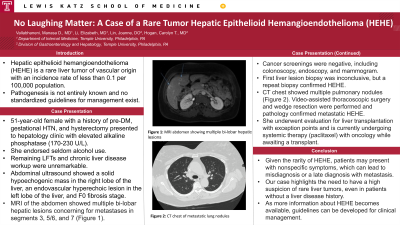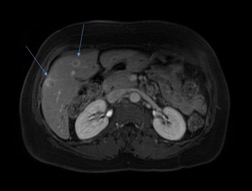Monday Poster Session
Category: Liver
P3145 - No Laughing Matter: A Case of a Rare Tumor Hepatic Epithelioid Hemangioendothelioma (HEHE)
Monday, October 28, 2024
10:30 AM - 4:00 PM ET
Location: Exhibit Hall E

Has Audio

Manasa Vallabhaneni, MD
Temple University Hospital
Philadelphia, PA
Presenting Author(s)
Manasa Vallabhaneni, MD, Elizabeth Li, MD, Joanne Lin, DO, Carolyn Hogan, MD
Temple University Hospital, Philadelphia, PA
Introduction: Hepatic epithelioid hemangioendothelioma (HEHE) is a rare liver tumor of vascular origin with an incidence rate of less than 0.1 per 100,000 population. The pathogenesis is not entirely known, and no standardized guidelines for management exist.
Case Description/Methods: A 51-year-old female with a history of pre-diabetes, gestational hypertension, and hysterectomy presented to hepatology clinic with elevated alkaline phosphatase in the 170-230 U/L range with remaining liver function tests within the normal range. She denied a personal or family history of liver disease, but endorsed a family history of lupus and uterine cancer. She reported seldom alcohol use, about 1-2 drinks during special occasions. Her physical exam and a comprehensive serological workup for chronic liver diseases were unremarkable. An abdominal ultrasound with elastography was obtained, which showed a solid hypoechogenic mass in the right lobe of the liver, an endovascular hyperechoic lesion in the left lobe of the liver, and F0 fibrosis stage. A subsequent MRI of the abdomen showed multiple bi-lobar hepatic lesions concerning for metastases in segments 3, 5/6, and 7. Tumor markers including AFP, CEA, CA 19-9, and CA-125, were negative.
After multidisciplinary discussion, age-appropriate cancer screenings were completed, including colonoscopy, endoscopy, and mammogram. CT chest was obtained to rule out metastasis and a liver mass biopsy was obtained. The first liver lesion biopsy was inconclusive, but a repeat biopsy confirmed HEHE. CT chest showed multiple pulmonary nodules, which were not amendable to biopsy given their small size. Video-assisted thoracoscopic surgery and wedge resection were performed, and pathology confirmed metastatic HEHE. She underwent evaluation for liver transplantation with exception points and is currently undergoing systemic therapy (paclitaxel) with oncology while awaiting a transplant.
Discussion: Given the rarity of HEHE, patients may present with nonspecific symptoms, which can lead to misdiagnosis or a late diagnosis with metastasis. Furthermore, treatment is challenging given the lack of studies and the absence of experience among providers. Our case highlights the need to have a high suspicion of rare liver tumors, even in patients without a liver disease history. With more information about HEHE available, guidelines can be developed for the clinical management of HEHE.

Disclosures:
Manasa Vallabhaneni, MD, Elizabeth Li, MD, Joanne Lin, DO, Carolyn Hogan, MD. P3145 - No Laughing Matter: A Case of a Rare Tumor Hepatic Epithelioid Hemangioendothelioma (HEHE), ACG 2024 Annual Scientific Meeting Abstracts. Philadelphia, PA: American College of Gastroenterology.
Temple University Hospital, Philadelphia, PA
Introduction: Hepatic epithelioid hemangioendothelioma (HEHE) is a rare liver tumor of vascular origin with an incidence rate of less than 0.1 per 100,000 population. The pathogenesis is not entirely known, and no standardized guidelines for management exist.
Case Description/Methods: A 51-year-old female with a history of pre-diabetes, gestational hypertension, and hysterectomy presented to hepatology clinic with elevated alkaline phosphatase in the 170-230 U/L range with remaining liver function tests within the normal range. She denied a personal or family history of liver disease, but endorsed a family history of lupus and uterine cancer. She reported seldom alcohol use, about 1-2 drinks during special occasions. Her physical exam and a comprehensive serological workup for chronic liver diseases were unremarkable. An abdominal ultrasound with elastography was obtained, which showed a solid hypoechogenic mass in the right lobe of the liver, an endovascular hyperechoic lesion in the left lobe of the liver, and F0 fibrosis stage. A subsequent MRI of the abdomen showed multiple bi-lobar hepatic lesions concerning for metastases in segments 3, 5/6, and 7. Tumor markers including AFP, CEA, CA 19-9, and CA-125, were negative.
After multidisciplinary discussion, age-appropriate cancer screenings were completed, including colonoscopy, endoscopy, and mammogram. CT chest was obtained to rule out metastasis and a liver mass biopsy was obtained. The first liver lesion biopsy was inconclusive, but a repeat biopsy confirmed HEHE. CT chest showed multiple pulmonary nodules, which were not amendable to biopsy given their small size. Video-assisted thoracoscopic surgery and wedge resection were performed, and pathology confirmed metastatic HEHE. She underwent evaluation for liver transplantation with exception points and is currently undergoing systemic therapy (paclitaxel) with oncology while awaiting a transplant.
Discussion: Given the rarity of HEHE, patients may present with nonspecific symptoms, which can lead to misdiagnosis or a late diagnosis with metastasis. Furthermore, treatment is challenging given the lack of studies and the absence of experience among providers. Our case highlights the need to have a high suspicion of rare liver tumors, even in patients without a liver disease history. With more information about HEHE available, guidelines can be developed for the clinical management of HEHE.

Figure: Figure 1: MRI abdomen showing multiple bi-lobar hepatic lesions concerning for metastases
Disclosures:
Manasa Vallabhaneni indicated no relevant financial relationships.
Elizabeth Li indicated no relevant financial relationships.
Joanne Lin indicated no relevant financial relationships.
Carolyn Hogan indicated no relevant financial relationships.
Manasa Vallabhaneni, MD, Elizabeth Li, MD, Joanne Lin, DO, Carolyn Hogan, MD. P3145 - No Laughing Matter: A Case of a Rare Tumor Hepatic Epithelioid Hemangioendothelioma (HEHE), ACG 2024 Annual Scientific Meeting Abstracts. Philadelphia, PA: American College of Gastroenterology.

